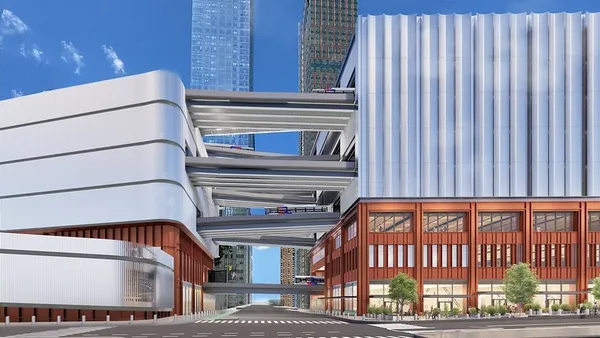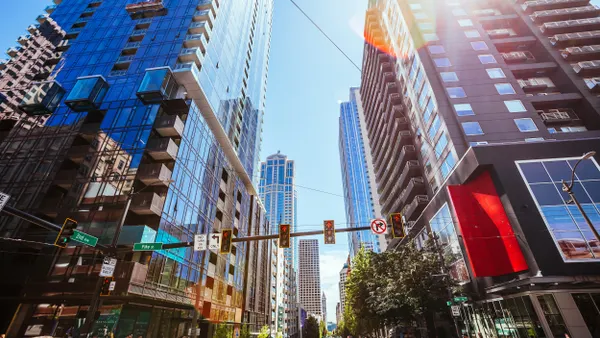As cities look to greener, less congested and more resilient futures, the temptation is often to raze old (and sometimes historically significant) buildings and start again — in many cases for research, technology or startup incubation purposes.
It is all a far cry from previous generations, when buildings of historical significance like the original Penn Station in New York City were razed to make way for new developments. And while such reimagination of old buildings is not a universal trend, it is notable and forcing cities to get creative.
Here are five cities that are looking to their past to build a more innovative future.
New York City: Moynihan Hall
Across the street from New York's Penn Station, a former post office and mail sorting facility is getting a new lease on life as a station for Amtrak and commuter rail services.
U.S. Sen. Daniel Patrick Moynihan, D-NY, first suggested more than 20 years ago that portions of the James A. Farley Post Office be converted into a 21st century train station, with space to have Amtrak and Long Island Rail Road (LIRR) trains come in to a new waiting area for passengers. It will also have digital wayfinding and signage as well as more food and shopping options. It is now known as Moynihan Hall (pictured above).
It comes as Penn Station is serving more than 650,000 passengers every day — despite being originally designed to serve only 200,000 — and with the station earning a certain notoriety for a poor commuting and transit experience.
The $3 billion redevelopment of Penn Station, of which Moynihan Hall is a part, was launched in 2016 and has been spearheaded by New York Gov. Andrew Cuomo. "This proposal will fundamentally transform Penn Station for the 21st century, and we are excited to move forward with the project in the days to come," Cuomo said in a statement at the time.
The project has been affected by delays but is expected to be completed by 2020.
Houston: Sears building
As the city continues to rebuild from Hurricane Harvey, Houston is looking to anchor a new innovation district in its Midtown neighborhood with the 75-year-old former Sears building. The 9.4-acre innovation district is planned to be a home for startups, food and entertainment, as well as "iconic" public space and leading infrastructure. Mayor Sylvester Turner and Rice University announced the district earlier this year.
"We are laying the groundwork to make Houston the next great center for startups and imaginative endeavors in the digital universe, and now we have a pivotal physical home for our work on the next frontier," Turner said in a statement at the time.
The former Sears building, which was built in 1939, and is being renovated for the project. The Houston Chronicle reported that its exterior is being restored to its original glory, undoing an effort to "modernize" it in the 1960s.
"So long, '60s corrugated metal," historic advocacy group Preservation Houston wrote in a Facebook post. "Can't say we're sorry to see you go."
Detroit: Michigan Central Station
Southwest of downtown Detroit, Michigan Central Station has sat vacant since 1988, having previously been a major hub for rail travel after its opening in 1914. The station gained a certain notoriety in a city filled with abandoned buildings, as it was vandalized repeatedly and guarded by state security.
But that changed late last year, as Ford announced it would renovate the former station and move in its electric and self-driving vehicle businesses from its corporate headquarters in Dearborn, MI. The company announced it had purchase the 18-story, 500,000-square-foot depot in June.
Incredible. Here are renderings from Ford. The company has big plans for their newly-acquired Michigan Central train station. pic.twitter.com/fTLYvTX1iN
— Brad Galli (@BradGalli) June 19, 2018
"The Michigan Central Station was a symbol of Detroit’s rise and fall," Michigan Lt. Gov. Brian Calley said in a Medium post when the purchase was announced. "It will now tell the story of Detroit rising again."
Ford is seeking nearly $239 million in tax breaks over 35 years for the renovation, which is also slated to include housing, office and retail space. The automaker said that eventually, the station will be part of a four-building campus, with 2,500 employees by 2022.
San Jose, CA: Diridon Station
There are big plans afoot for Diridon Station and the surrounding area in San Jose, CA, from the city, transit agencies and Google. Already served by Amtrak and commuter rail services, the station, which was built in 1935, is projected to have service from Bay Area Rapid Transit (BART) beginning in 2026 as part of the Silicon Valley BART extension. That plan will make BART more widely available, and ease congestion on the rails in San Jose by offering travelers more options.
Near the station, Google bought a mixed-use project earlier this year to become part of its San Jose operations. It is set to include publicly-accessible parks and public spaces, as well as optimized connections to trains, buses, BART and bicycle and pedestrian facilities.
DIRIDON Station Animation from Kilograph on Vimeo.
"In the years ahead, several major transportation investments — including BART, High Speed Rail, Bus Rapid Transit, and an electrified Cal Train, along with existing lines that include Capitol Corridor, ACE, Amtrak, and VTA Light Rail — will converge at Diridon Station, bringing an expected eight-fold increase in daily commuters, and an opportunity to transform Downtown San Jose,” the Silicon Valley Organization wrote on a webpage about the project.
Construction is projected to get underway in 2020. It has come in for criticism from some local opponents, who deride the project as creating "Googleville," a reference to the Hooverville shanty towns built during the Great Depression by the poor.
Louisville, KY: The Green Building
Fall 2008 marked the opening of the Green Building in Louisville, KY, the first commercial building in the city to be Platinum LEED certified, and Kentucky’s first Platinum LEED adaptive reuse structure.
The building was a dry goods store, but its owners decided in 2007 to renovate it and add features like a 40-foot-high lobby, natural lighting, eco-friendly materials and renewable energy systems. The building also uses solar power, geothermal wells and other environmentally-friendly ways to generate power.
It now hosts a contemporary art space, event areas, offices, headquarters of a record label and other businesses.










